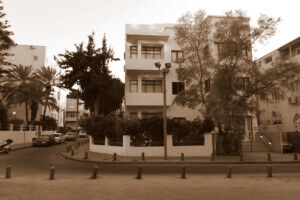Biennales have proliferated in recent years marking the redistribution of culture and also its global consumption. Once wed to the rarefied setting of Venice, they can now be found in Barcelona, Rio, Lisboa and… Bat Yam.
“Bat Yam?” you ask. In this unknown and unlikely Israeli town, the curators of the Bat-Yam Biennale of Landscape Urbanism have fashioned a wonderful new genre of biennale that is more “urban action” than exhibition. A rather poor, largely Russian immigrant “outer borough” of the elegant white city of Tel Aviv, Bat Yam calls to mind Brighton Beach with palm trees. The city constitutes a frayed but dignified modernist fabric built from an amazing array of gemütlich variations on the Maison Citrohan with a sensitive implementation of the tenets of open space, light, air, and the hierarchy of ways.
While the biennale provides the city with an array of quasi-permanent installations of public art, architecture, and landscape as catalysts for its growth and transformation, the exhibition continues to search for new strategies to sustain a city that lacks both the opportunities but also the limitations of development-driven planning.
The two curators, Yael Moira-Klein and Sigal Barnir frame their appreciation of Bat Yam’s modernist town planning within an acknowledgement of the problems it faces: most significantly, a dearth of property for the kind of commercial development on which the Israeli tax structure is based. Indeed, the construction sites that became fertile ground for the biennale exhibits are the very last that remain. A comparison with the neighboring town of Holon is illuminating. Awash with cranes and mixed-use towers, property rich Holon can use development per se as its planning strategy and then give it an identifiable urban image through hi-profile projects such as the new Ron Arad Design Museum. In the absence of such raucous development, the curators ask, what is Bat Yam to be?
The Biennale’s formal theme “Timing” attacks city planning and development from the point view of landscape and its partnership with long-term unpredictable growth. Embracing this point of view, the Bat-Yam municipality offered up part of their annual public works budget as a funding source along with fallow city properties as sites for projects, at least for now. And so a glowing lantern hooked to a construction crane at night entitled “Skylight” will remain only until its tower is complete. Several empty lots so small as to evade development are currently transformed into social hangouts. Meanwhile, at other installations, the powder coated steel arcade of “On the Way to the Sea” will remain a welcome long-term fixture in the municipal park; but the mobile trees in boxes from the “Roaming Forest” and the landscaped craters of “Observing Horizon” will only come of age over the next several years.
This robust concept of timing gracefully frames issues of sustainability as matters of “persistence.” The “Great Butterfly Experiment” counters the widespread recession of butterflies with the installation of 150,000 butterfly-attracting plants and a truly lovely pavilion to welcome them back. “Tamogotchi Park” takes on the serious matter of water supply with a Rube Goldberg affair of a child-operated merry-go-round that pulls the ocean through pipes to a tower where it is desalinated and then fed to plants under individual polycarbonate bubbles.
The long-term curatorial intention of importing these projects to Bat Yam is the cultivation of “urban action” from within. No high price tag installations have been installed to re-brand Bat Yam as the next art biennale capital; rather on-the-cheap opportunistic interventions prod the municipality and the residents to first take note of their city and then hopefully to take part. The curators used the biennale to actually jump start grassroots organization by commissioning teams of designers and sociologists to identify small sites of public/private ambiguity like parking strips and to organize the neighbors/stakeholders around collaborative designs for their improvement.
Within the Biennale’s light heartedness lie serious questions of the politics of permanence and stability. On a moonlit walk along the Mediterranean heading south from Tel Aviv through Jaffa to Bat Yam, it emerged that the sole neighborhood with no direct access to the beach is predominately Arab. By simply making Bat Yam a destination, the Biennale created a sense of imaginative continuity among these three waterfront communities. And if it did not yet exist then surely it could, as various city officials hope, given the shared economic and social opportunities that mutual “urban action” along such a beachfront would bring. Here is the promised city of “Timing.”










